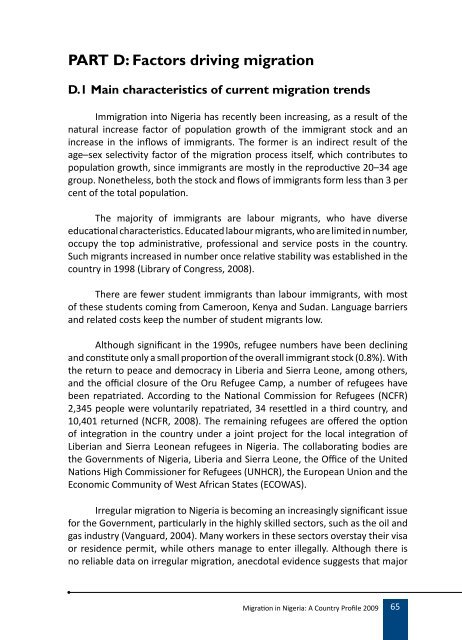Migration Profile on Nigeria - IOM Publications - International ...
Migration Profile on Nigeria - IOM Publications - International ...
Migration Profile on Nigeria - IOM Publications - International ...
You also want an ePaper? Increase the reach of your titles
YUMPU automatically turns print PDFs into web optimized ePapers that Google loves.
parT D: Factors driving migrati<strong>on</strong><br />
D.1 main characteristics of current migrati<strong>on</strong> trends<br />
Immigrati<strong>on</strong> into <strong>Nigeria</strong> has recently been increasing, as a result of the<br />
natural increase factor of populati<strong>on</strong> growth of the immigrant stock and an<br />
increase in the inflows of immigrants. The former is an indirect result of the<br />
age–sex selectivity factor of the migrati<strong>on</strong> process itself, which c<strong>on</strong>tributes to<br />
populati<strong>on</strong> growth, since immigrants are mostly in the reproductive 20–34 age<br />
group. N<strong>on</strong>etheless, both the stock and flows of immigrants form less than 3 per<br />
cent of the total populati<strong>on</strong>.<br />
The majority of immigrants are labour migrants, who have diverse<br />
educati<strong>on</strong>al characteristics. Educated labour migrants, who are limited in number,<br />
occupy the top administrative, professi<strong>on</strong>al and service posts in the country.<br />
Such migrants increased in number <strong>on</strong>ce relative stability was established in the<br />
country in 1998 (Library of C<strong>on</strong>gress, 2008).<br />
There are fewer student immigrants than labour immigrants, with most<br />
of these students coming from Camero<strong>on</strong>, Kenya and Sudan. Language barriers<br />
and related costs keep the number of student migrants low.<br />
Although significant in the 1990s, refugee numbers have been declining<br />
and c<strong>on</strong>stitute <strong>on</strong>ly a small proporti<strong>on</strong> of the overall immigrant stock (0.8%). With<br />
the return to peace and democracy in Liberia and Sierra Le<strong>on</strong>e, am<strong>on</strong>g others,<br />
and the official closure of the Oru Refugee Camp, a number of refugees have<br />
been repatriated. According to the Nati<strong>on</strong>al Commissi<strong>on</strong> for Refugees (NCFR)<br />
2,345 people were voluntarily repatriated, 34 resettled in a third country, and<br />
10,401 returned (NCFR, 2008). The remaining refugees are offered the opti<strong>on</strong><br />
of integrati<strong>on</strong> in the country under a joint project for the local integrati<strong>on</strong> of<br />
Liberian and Sierra Le<strong>on</strong>ean refugees in <strong>Nigeria</strong>. The collaborating bodies are<br />
the Governments of <strong>Nigeria</strong>, Liberia and Sierra Le<strong>on</strong>e, the Office of the United<br />
Nati<strong>on</strong>s High Commissi<strong>on</strong>er for Refugees (UNHCR), the European Uni<strong>on</strong> and the<br />
Ec<strong>on</strong>omic Community of West African States (ECOWAS).<br />
Irregular migrati<strong>on</strong> to <strong>Nigeria</strong> is becoming an increasingly significant issue<br />
for the Government, particularly in the highly skilled sectors, such as the oil and<br />
gas industry (Vanguard, 2004). Many workers in these sectors overstay their visa<br />
or residence permit, while others manage to enter illegally. Although there is<br />
no reliable data <strong>on</strong> irregular migrati<strong>on</strong>, anecdotal evidence suggests that major<br />
<str<strong>on</strong>g>Migrati<strong>on</strong></str<strong>on</strong>g> in <strong>Nigeria</strong>: A Country <str<strong>on</strong>g>Profile</str<strong>on</strong>g> 2009<br />
65

















